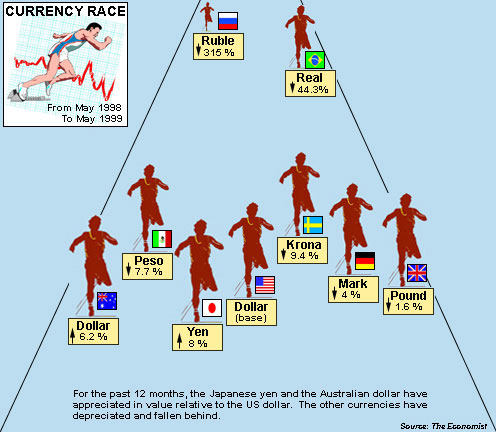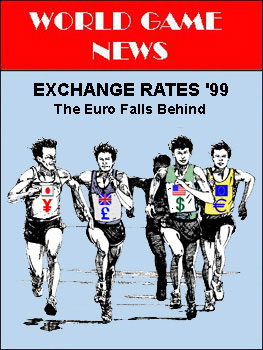
 May
31, 1999 Europe's new currency unit, the euro, has fallen 10 %
since
it began trading in January. At the beginning of the year, the
euro
was worth $1.17. Now it's worth less than $1.05. Some
speculate
that it could fall further behind the dollar over the rest of this
year.
"Ninety-nine in '99 remains a possibility," a top official at Deutsche
Bank quipped to a New York Times reporter last week (meaning
that
the euro could fall to $0.99 by the end of this year).
May
31, 1999 Europe's new currency unit, the euro, has fallen 10 %
since
it began trading in January. At the beginning of the year, the
euro
was worth $1.17. Now it's worth less than $1.05. Some
speculate
that it could fall further behind the dollar over the rest of this
year.
"Ninety-nine in '99 remains a possibility," a top official at Deutsche
Bank quipped to a New York Times reporter last week (meaning
that
the euro could fall to $0.99 by the end of this year).
Like most economic events, this is both bad and good news for the people who reside in the E-11 countries. [The eleven countries which belong to the European Monetary Union are: Germany, France, Italy, Spain, Netherlands, Austria, Belgium, Luxembourg, Finland, Portugal, and Ireland. Their national currencies are pegged to the euro]. The bad news is that those people who own euros and euro denominated assets are relatively poorer. Because their currency unit has depreciated, the prices of merchandise and services from the United States, the United Kingdom, and Japan are (in effect) higher. They now have to exchange more euros (and marks or francs or lira) to get a US dollar, a British pound, or a Japanese yen. Their terms of trade are deteriorating.
However, the good news is that European products have become cheaper to foreigners. This will stimulate export sales, tourism, and jobs in Western Europe as well as help keep the wheels of the European economy turning. While other economies have picked up speed, the European economies have slowed down recently. A currency depreciation may help them get the boost they need..
Currency exchange markets are essential for international trade and finance. The ability to exchange one currency for another is the monetary link between nations. These markets allow trade merchants to circumvent bartering that would otherwise be too cumbersome. So what determines the exchange rate between two currencies? The short answer is: "Supply and demand."
People demand foreign currencies to buy goods and services, travel, and make foreign investments. They supply their own currency to demand other currencies. When the supply of a currency increases, its price falls. When the demand for a currency goes up, so does its exchange value. The euro will fall (and the dollar will rise) when the demand for dollars is greater than the demand for euros in the foreign exchange market.
Business cycles and expectations play major roles in foreign exchange markets. Most analysts think that the dollar is going up in value relative to the euro because people believe the US economy is strong, and they are moving their investments to the United States. A strong US economy and stock market, combined with higher interest rates in the US than in Europe, and expectations that Europe's new monetary union may stumble in its early stages, all point to a strong demand for dollars and a weak demand for euros.
Flexible exchange rate systems that permit market forces to operate have a built-in stabilizing mechanism. As the dollar gets more and more expensive, US exports become less and less competitive and investments in the US become less attractive. Meanwhile, as the euro gets cheaper, European exports become more competitive and foreign investment in Europe becomes more attractive. At some point, the exchange value of the dollar will peak, stabilize, or may even begin to decline. The turning point is what currency speculators would like to know.
Ever since the world's largest trading nations abandoned the gold-exchange system in the 1970s, exchange rates have been primarily determined by free market forces. Some countries still officially fix or peg their national currency to a key currency such as the US dollar, but most nations have adopted an independently floating system. Central banks do intervene occasionally to persuade a currency up or down by leaning against the wind, but market forces tend to prevail in today's foreign exchange climate.
When analyzing foreign exchange markets, time is an important element. Although exchange rates fluctuate minute by minute, most analysis is confined to daily, weekly, monthly, quarterly, annually, or longer periods of time. It makes a difference where you begin and end your analysis, because a currency could fall in one month but rise over the course of a year. The strongest currency in the world over the past 12 months has been the Japanese yen. There is still a strong demand for the Japanese yen to buy Japan's automobiles, consumer electronics, and other products. Japan runs a trade surplus with virtually all of its trading partners, and Japan's recession has weakened its demand for other countries' goods and services.
The picture below likens exchange rates to a race. The currency that goes up in value the most gets ahead, and those currencies that are depreciating fall behind. The US dollar is used as the base currency. The Japanese yen has appreciated by 8 per cent relative to the US dollar over the past 12 month period. The German mark, on the other hand, has fallen vis-a-vis the US dollar by almost 4 per cent. [Because they are linked, most of the other E-11 currencies depreciated at nearly same rate as the German mark]. The Brazilian real has depreciated dramatically, especially since January of this year; and the Russian ruble has virtually run out of gas. Last year, 6 rubles exchanged for 1 dollar. Now it takes 25 rubles to get a dollar (assuming you could get someone to make the exchange).

The Bank of England compiles and maintains an interesting
trade-weighted
exchange rate index, using 1990 as the base year. The index is
weighted
by the proportion of trade that each nation engages in with its trading
partners. For example, the United States' biggest trading partner
is Canada. If the US dollar were to appreciate (or depreciate)
relative
to the Canadian dollar that would affect the index more than if the US
dollar were to appreciate (or depreciate) relative to a smaller trading
partner's currency like the Italian lira or the Brazilian real.
According
to this index, the Japanese yen has been the strongest currency over
the
decade of the 1990s. Its exchange value is 25 per cent higher now
than it was at the beginning of the decade. The Spanish peseta
and
the Italian lira have depreciated by approximately 25 per cent over the
same period. [See Table below]. The US dollar ranks second to the
yen, having appreciated by nearly 10 per cent. The Australian
dollar,
which has shown strength over the past 12 months, is still down by
about
13 per cent since 1990.
|
|
|
|
|
|
|
|
|
|
|
|
|
|
|
|
|
|
|
|
|
|
|
|
|
|
|
|
|
|
|
|
|
|
|
|
|
|
|
|
|
|
|
|
|
|
|
|
|
|
|
|
|
|
|
|
|
|
|
|
|
|
|
So what do you think will happen to the value of the Japanese yen,
the
US dollar, the European euro, and other currencies over the next 12
months?
the next 10 years? Forecasting exchange rates is one of the most
difficult assignments that economists undertake. They are not
really
very good at it. But they are better than everybody else!
That's
why they get paid to do it. The foreign exchange market is just
one
more fascinating aspect of The World Game of Economics.
Recommended Links for up-to-date exchange rates and currency converters:
The World Game of Economics (C) 1999 Ronald W. Schuelke All Rights Reserved